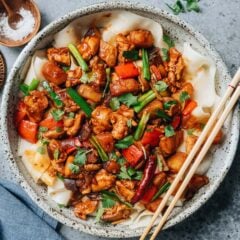
Da Pan Ji (Big Plate Chicken, 大盘鸡)
Hearty, spicy, and supremely satisfying, big plate chicken is the iconic Xinjiang dish that brings together tender chicken, velvety potatoes, and wide noodles in a bold, aromatic sauce.
Ingredients
- 1 batch wide homemade pulled-noodles (or 8 oz / 225 g dried noodles)
- 2 tablespoons Shaoxing wine
- 2 tablespoons light soy sauce
- 2 teaspoons dark soy sauce
- 1 tablespoon doubanjiang
- 1 teaspoon sugar
- 1 thumb ginger , thinly sliced
- 6 cloves garlic , smashed
- 4 scallions , sliced into 1” pieces
- 1/2 red onion , sliced into 1/2” pieces
- 8 dried Chinese chili peppers
- 2 star anise pods
- 2 bay leaves
- 1/2 teaspoon ground Sichuan peppercorn
- 1 cinnamon stick
- 2 tablespoons peanut oil (or vegetable oil)
- 4 boneless chicken thighs , diced to 1” (2.5 cm) pieces
- 1 1/2 cups chicken stock
- 1 russet potato , roll cut into 1/2” pieces (*Footnote 1)
- 1 red pepper , cut into 1 1/2” pieces
- Chopped cilantro for garnish (Optional)
Instructions
- Prepare the noodle dough if you’re planning to use homemade noodles.
- Mix Shaoxing wine, light and dark soy sauce, and sugar in a small bowl.
- Add the ginger, garlic, onion, dried chili pepper, star anise, bay leaves, Sichuan peppercorns, and cinnamon to a small plate.
- Boil the noodles according to instructions. Once done, drain and rinse with cold water to stop cooking. Then drain again.
- Heat oil in a wok until shimmering. Add the chicken. Cook, stirring occasionally, until the surface turns light golden.
- Add the plate of the spices to the wok. Stir and cook for 30 seconds to release fragrance. Add doubanjiang and cook until all the spices are coated. Add the Shaoxing wine mixture. Stir immediately to deglaze the wok.
- Pour in water and add potato. Cook over medium-high heat until bringing to a simmer. Cover and simmer over medium heat for 5 minutes (*Footnote 2).
- Add bell pepper. Keep simmering for another 5 minutes until the vegetables turn tender. Stir in the scallion and cook for another minute.
- If the broth is still too thin, turn to high heat to reduce the sauce. Stir constantly to prevent burning. Once done, transfer everything to a big bowl. Remove as much dried spices as you can and discard them.
- Serve the chicken, vegetables and sauce over boiled noodles. Garnish with cilantro if desired.
Notes
- Hold your knife at about a 45 degree angle relative to the potato. Cut 1” from the end. Roll the potato towards you until the cut side is facing up then cut again 1” from the end at the same angle. Repeat the rolling and cutting. All the potato pieces should be roughly triangular in shape. This is a common knife technique in Chinese cooking, to create more edges on tougher vegetables so they soak up flavor while braising.
- The broth should retain a low boil, so the sauce slowly reduces, and thickens up as the fat emulsifies.
Nutrition
Serving: 1serving, Calories: 595kcal, Carbohydrates: 65g, Protein: 40g, Fat: 19.1g, Saturated Fat: 4.1g, Cholesterol: 148mg, Sodium: 890mg, Potassium: 522mg, Fiber: 3.7g, Sugar: 7.3g, Calcium: 57mg, Iron: 3mg